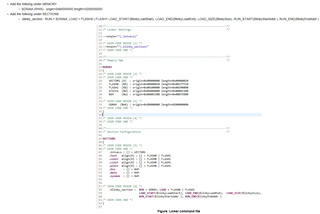主题中讨论的其他器件:TMS570LC4357、
尊敬的 TI 团队:
1. 我将尝试通过以下线程中建议的方式更改链接器脚本文件、从 SDRAM 执行代码。
我当前修改的脚本文件如下:
/ /
/*禁止警告和错误:*/
/*#10199-D CRC 表运算符(crc_table_for_<>)已忽略:
CRC table 运算符无法与空输出段关联*/
--diag_suppress=10199
--retain=interruptVectors
#define APP_BASE 0x60000000
#define RAM_BASE 0x60100000
内存
{
FLASH (RX):origin = APP_BASE,length = 0x00100000
SRAM (rwx):origin = RAM_BASE、length = 0x00040000
}
/*以下命令行选项作为 CCS 项目的一部分设置。 */
/*如果您正在使用命令行进行构建,或者出于某种原因想要*/
/*在此处定义它们,您可以根据需要取消注释和修改这些行。 */
/*如果您使用 CCS 进行构建、则最好制作任何此类项目*/
/*对 CCS 项目的修改,并保留该文件。 */
/**/
/*--heap_size=0 */
/*--stack_size=256 */
/*--library=rtsv7M4_T_le_eabi.lib */
/*内存中的段分配*/
部分
{
#ifndef gen_crc_table
.intvecs:> app_base
.text :>闪存
.const :>闪存
cinit :>闪存
请输入您的密码:> FLASH
.rodata :>闪存
init_array:> FLASH
#else
.intvecs:> 0x00000000、crc_table (crc_table_for_intvecs)
.text:> flash、crc_table (crc_table_for_text)
.const:> FLASH、crc_table (crc_table_for_const)
.cinit:> flash、crc_table (crc_table_for_cinit)
.pinit:> FLASH、crc_table (crc_table_for_Pinit)
.rodata:> FLASH、crc_table (crc_table_for_Pinit)
init_array:> FLASH、crc_table (crc_table_for_init_array)
.TI.crctab:>闪存
#endif
.vtable:> RAM_BASE
.data :> SRAM
bss :> SRAM
.sysmem:> SRAM
.stack:> SRAM
}
__STACK_TOP =_STACK + 512;
******************* /
1.将.out 文件数据复制到 SDRAM 后,我将调用下面的函数。
******************* /
uint32 entryPiont;
entryPiont = 0x60000000;//SDRAM 存储器地址
appEntry =(void (*)(void)) entryPiont;
(* appEntry)();
***************** /
2.代码未按预期从 SDRAM 执行。
3.是否需要在链接程序脚本或更高级别的函数中进行任何修改?
此致、
Naga Narasimha Rao P



